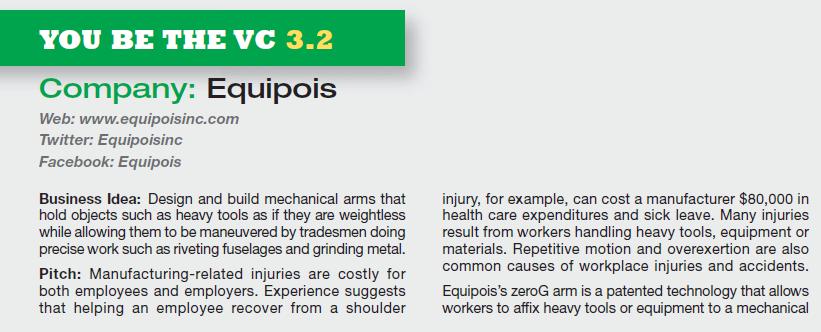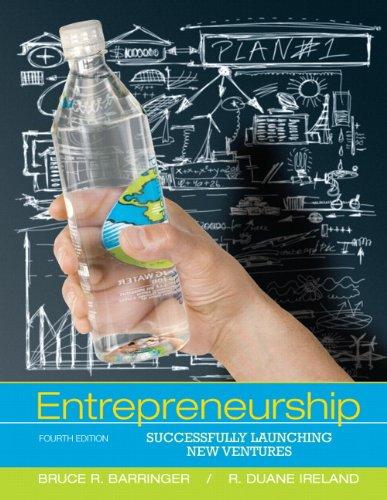Just a few years ago, Tom Patterson was working as a medical device salesman. Today, his company,
Question:
Just a few years ago, Tom Patterson was working as a medical device salesman. Today, his company, Tommy John, brings in about $2 million in revenue and makes the top selling men’s undershirts at Neiman Marcus and Nordstrom. How does that happen? Patterson had no prior experience in the men’s clothing industry—just a problem to solve and a lifetime desire to be an entrepreneur. It’s an interesting story, and a good reminder of how important feasibility analysis is.
Tom Patterson and His Frustration with Undershirts
Tom Patterson grew up in South Dakota. He started wearing undershirts when he was 8. Like many boys and men, wearing an undershirt became part of his everyday life. But for Patterson, this was frustrating in that he found himself constantly tucking his undershirt into his pants. Over time, he became increasingly aggravated with the way undershirts were made. To Patterson, men’s undershirts were too baggy, too boxy, and they just weren’t made to fit well. Patterson remembers when his frustration reached a boiling point. One day when he was working in medical sales, he had a presentation at a hospital. He remembers driving to the hospital and getting out of his car, and his undershirt had bunched up and was half way up his chest.
That day, following the presentation, Patterson went to several department stores and asked sales clerks if they carried men’s undershirts that would solve his problem. None of them did. One clerk even told Patterson that if he found a solution to let him know—he’d like to buy the undershirts too. Patterson followed up by sketching the type of undershirt that he wanted—long and tailored—and took it to a dry cleaner that he was familiar with that employed a tailor. He showed the drawing to the tailor, who was unenthused about the idea but agreed to make him a prototype. He got the prototype and loved it.
It solved the frustrations that he’d been having with undershirts since he was a boy. By this point, Patterson wondered if he had stumbled on a business idea.
Product and Industry Feasibility Analysis
Patterson went back to the tailor and asked for 15 more shirts. He sent them out to family and friends, asking that they give him feedback but keep his product idea to themselves. The most common response he got was, “Tom this is incredible, can I order five or six more?” He had no idea what to do next. He decided to keep his medical device sales job until he found out whether his undershirt idea really had legs. He then drove to the garment district in Los Angeles, not knowing a soul. He started asking around about who could make him some men’s undershirts, and the 12th person he talked to called a friend and made an introduction. The garment maker he met that day became his first producer, and made about 200 more undershirts for Patterson.
After Patterson paid for the 200 undershirts, he contacted a patent attorney, based on a friend’s advice.
Through a friend of a friend he found a patent attorney who specialized in apparel products. He paid $300 for a preliminary patent search, and found that there was no comparable product. He filed a provisional patent and decided to keep his medical sales job and to spend the next year continuing to assess the potential for his product. After that, he’d decide whether to spend the money to file for a regular utility patent.
During the next several months, Patterson, buoyed by growing evidence that he had a unique idea, did a lot of online research about undershirts and the men’s undershirt industry. He found that men’s undergarments are a $30 billion industry worldwide. He also found that although the industry is dominated by major brands, such as Hanes and Fruit of the Loom, a number of small businesses had found success in the undergarments market as well, by identifying and filling niches the major brands ignored. He would go to stores and literally spend hours watching people buy men’s undershirts. There were two things he found out by watching people buy undershirts. First, people either bought quickly or seemed a little confused when they looked at the alternatives.
When he stopped people who bought quickly and politely asked about how they picked their brand, they would normally say that it’s the brand of undershirt they’ve been buying for years. The second thing he found out was that men only buy undershirts for about 17 years of their life. From age zero to 17 their mothers buy their undershirts, and from age 34 (or whenever they get married) on their wives buy it. So the majority of the people who buy men’s undershirts are women.
Tommy John Undershirts
During this period—early 2008—Patterson continued to work on prototypes for his undershirt, and decided on the name Tommy John. He studied all the major brands, turning dozens of shirts inside out, measuring proportions, and testing fabric blends to develop the perfect combination of fit, function, comfort, breathability, and style. The design he settled on is made of a soft yet durable fabric named micro modal (it’s derived from beech trees). It’s cut to be form fitting without feeling snug and promises “not to ride up, bunch up, or come unbuckled.”
The shirts are machine wash and tumble dry.
Along with the shirt itself, Patterson felt that the package design was critical to the firm’s success. All the packages for men’s undershirts looked pretty much the same—they had the company’s logo and a good looking guy on the front. Patterson designed a box with very feminine colors, chocolate brown and Tiffany blue, specifically to catch the eye of women, the primary purchasers of men’s undershirts. The box clearly explained the problem the undershirt solved, and invited the shopper to feel the product for themselves. The box was designed to slide open easily, so a shopper could touch the undershirt. A survey confirmed Patterson’s intuition about the colors for the box. Women had high positives for both chocolate and Tiffany jewelry, so the almost dessert-like color for the box turned out to be a big plus.
In late 2008, Patterson was laid off from his medical sales job. He knew he had a product that filled a need.
The question was whether he could get distribution of his product. He decided to commit to Tommy John fulltime and work toward landing the types of retail partners he’d need to make Tommy John a full-time effort.
Neiman Marcus
To get retail distribution, he first tried men’s specialty stores. He called his undershirts The Second Skin Collection, based on the idea that they fit so well they felt like a “second skin.” The first nine stores said no, but the 10th displayed interest and he had his first retailer. The question was whether he could land a department store as a customer. Through industry research, Patterson knew that the majority of men’s undershirts were sold through department stores, so he’d need to land a department store to get significant sales. So with $800 left in his checking account, he got through to the Neiman Marcus buyer in Dallas and pitched Tommy John undershirts over the phone. Patterson had read that Neiman Marcus was known for giving new apparel companies a try. The buyer, who was a female, agreed to a meeting the following week. Before he hung up the phone, Patterson asked the buyer if she’d mind if he send samples of his undershirt to her husband and several men in her office to try before the meeting. The buyer agreed and the appointment was set.
When Patterson met the buyer the next week, she immediately said that she’d been getting rave feedback on his undershirts, and that she wanted to test them in 15 Neiman Marcus stores. She also said she never knew the struggles that men had with traditional undershirts.
Within the first month, Patterson’s undershirts achieved a 60 percent sell-through rate, nearly double the national rate for a successful clothing brand. By the third month, Neiman Marcus had expanded its test to 42 stores, and today Tommy John undershirts are in Neiman Marcus stores nationwide.
Neiman Marcus was the “crack in the door”
(Patterson’s words) that he needed. Three months later, Nordstrom signed on, and the Tommy John brand has now expanded to department stores and men’s specialty stores across the United States.
Looking Forward
Looking forward, Patterson plans to continue to expand market penetration for Tommy John. One of the most frequent questions he gets is when Tommy John will expand into women’s undergarments. So far, Patterson has resisted expanding into women’s clothes. He feels the women’s undergarment market is well served by existing companies, and wants to focus on his Second Skin line of men’s undershirts for the foreseeable future.
Discussion Questions
1. Write a concept statement for Tommy John. If Tommy John was still in the start-up stage and Tom Patterson asked you to whom he should distribute the concept statement, what would you have told him?
2. What type of gumshoe research did Tom Patterson benefit from when he was developing Tommy John, and what additional gumshoe research could he have conducted while he was investigating the feasibility of his business?
3. Make a list of the people whom Tom Patterson talked to about his product during the design phase. What insight(s) does this list provide you about the nature of the feasibility analysis process? Were there any tactics that Tom Patterson used to get feedback about his product that you think were particularly clever?
4. Complete a First Screen analysis for Tommy John.
What did you learn from the analysis?
Application Questions
1. What types of insights did Tom Patterson pick up by spending hours in stores watching people buy men’s undershirts? What role did these insights play in the final design of the product? In what ways do you think Tommy John products might be different today if Tom Patterson hadn’t spent the time watching people buy men’s undershirts that he did?
2. Read the “You Be the VC 3.2” feature in this chapter. If you had started Equipois, how would you have set up its product/service feasibility analysis?

Step by Step Answer:

Entrepreneurship Successfully Launching New Ventures
ISBN: 9780132555524
4th Edition
Authors: Bruce R. Barringer, R. Duane Ireland





